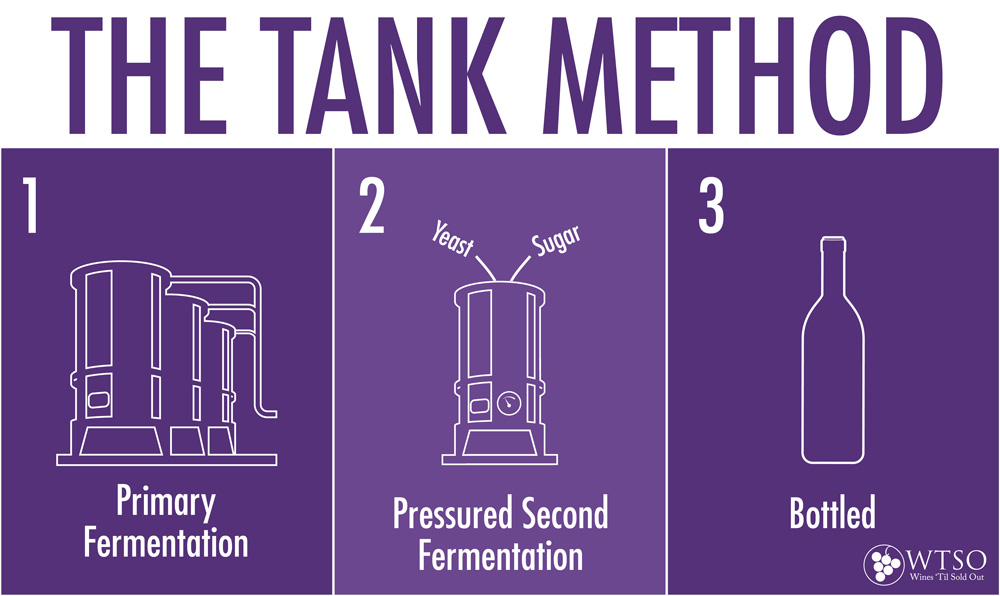As a company who sells many different sparkling wines, we’re often asked about the differences between them. Why does Champagne have a higher price point? Will Cava taste similar to Prosecco? Are all sparkling wines the same, just made in different countries?
Before discussing the differences, we should go over a few basics. Champagne, Cava, and Prosecco are all styles of carbonated – or sparkling – wine. The differences are due to regions of origin, growing conditions in the vineyards, the grape varieties used, and the method of production.
There are two main methods of production, and the two utilize different techniques: the traditional method (also known as the Champagne Method) and tank method (also known as the charmat method). The traditional method is described in detail in our post Champagne 101, which discusses how carbonation evolves directly in the bottle. The tank method, on the other hand, makes use of large tanks that contain the carbon dioxide resulting from fermentation. It’s less expensive than the traditional method, and produces wines with less carbonation.

Below are the three most popular styles of sparkling wine and what makes each unique.

Champagne

Champagne was not only the first sparkling wine, it’s also the most famous, and expensive. The word ‘Champagne’ is the name of the wine and the region it comes from. Champagne has played an important role in the history and heritage of France. For example, Champagne was poured to celebrate the end of World War II, when the allied armies were headquartered in the heart of Champagne – a place where the kings of France were crowned since Charlemagne.
History and heritage aren’t the only reasons for the success of Champagne. The quality of the wine itself is undeniable. Excellent growing conditions and careful utilization of the traditional method result in unrivaled sparkling wine – worth its price for special occasions. The three grapes of Champagne are Pinot Noir, Pinot Meunier, and Chardonnay, and the final results can vary on the levels of sweetness: Brut Nature to Doux.
Cava
In 1871, José Raventós from Cataluña, Spain, visited Champagne and became enamored with their bubbly. He decided to try his hand at making something similar back home, where he established the Codorníu family of wines. These early Spanish sparkling wines were called ‘Champaña,’ and were made in the traditional method. It wasn’t until 1970 that Spanish Sparkling wines were renamed Cava, after protests from the French that the word ‘Champaña’ was too similar to the word ‘Champagne,’ and therefore was misleading.
Cava is still made in the traditional method, but uses different grapes than Champagne. Many varietals are permitted, but the main three are indigenous to Spain: Macabeo, Parellada, and Xarello. Although 95% of Cava is still from Cataluña, it can be made in diverse regions all over Spain. A great deal of Cava is produced, and prices can be amazingly low. It represents a great value for anyone looking to drink sparkling wine on a regular basis.
Prosecco

The verdant hills and plains of the Veneto region in northeastern Italy are home to one of the most popular sparkling wines in the world. Prosecco is made from a grape called ‘Glera,’ and is made in the tank method. It’s usually inexpensive, and made in a slightly sweet style – confusingly labelled, ‘Extra Dry.’
Champagne and Cava spend a long time in contact with yeast during their production, which gives them both a rich, toasty flavor, reminiscent of bread or pastry. Prosecco, by contrast, spends limited time in contact with yeast so it has a clean, refreshing taste, full of fresh fruit flavors and minerality. Although Prosecco is generally less expensive and complex than Champagne, many people like it just as well, with its appealing aromas and clean finish. Prosecco is perfect for everyday drinking and entertaining.
Now that we’ve clarified the differences between the most popular sparkling wines, you can shop for bubbly depending on what style you’re looking for!



